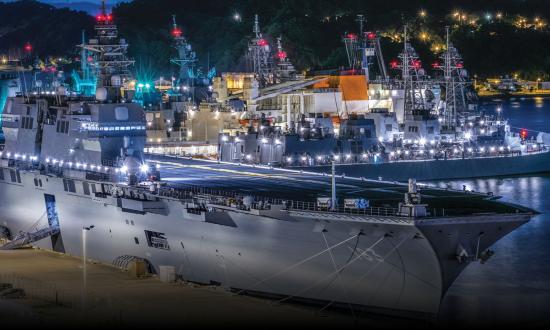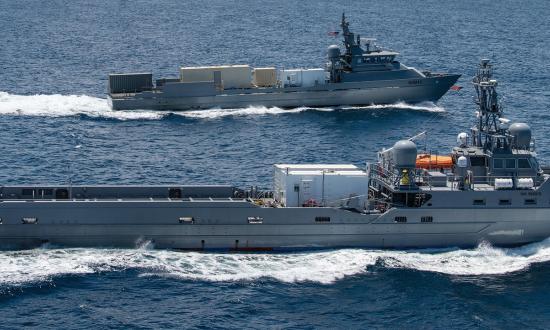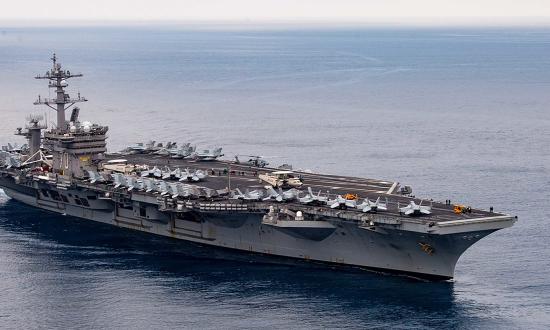It is roughly 6,000 nautical miles, as the missile flies, between San Diego and Taiwan, and a bit more than 5,000 from Seattle. Russia’s invasion of Ukraine and the 40th anniversary of the Falkland Islands War have sharpened attention on the challenges surrounding sustainment of U.S. forces in the western Pacific should those miles ever have to be covered in the face of determined opposition.
The Russian invasion of Ukraine, especially, has concentrated the minds of Western analysts on contested logistics. Months of preparation notwithstanding, in its opening phases at least, the invasion that began on 24 February appeared to suffer from woeful logistics despite having a comparatively short tail.
Photos and videos posted to social media showed Russian armored vehicles, tanks, and trucks frequently stopped on the side of the road seemingly without fuel, and rumors of inadequate food supplies for Russian troops were rampant. This resulted, in early March, in military and national security Twitter accounts full of memes and posts from U.S. S-4/N4 logistics types triumphantly recounting what can go wrong when planners neglect their areas of expertise.
Proceedings readers should be very familiar by now with the Navy and Marine Corps’ attention to contested littoral operations and its subsidiary, expeditionary advanced base operations. Many authors have attended in particular to the challenge of sustaining such operations inside the “weapons engagement zone” of China’s oft-discussed antiaccess/area-denial network of antiship and antiaircraft weapons. One idea that has received attention on multiple occasions in recent years is for the Navy to employ seaplanes for everything from insertion of special operations forces to air-to-air refueling. Were the Navy to explore seaplane logistics and sustainment seriously, it would not be the first modern military to do so.
The AVIC AG600 amphibian, in development in China for eight years, has a reported range of 2,400 nautical miles (nm) and maximum takeoff weight of 118,000 pounds (from a hard surface; it is a bit less from water).
Russia’s Beriev Be-200 has been in service since the early 2000s. According to the manufacturer, the amphibian has a maximum takeoff weight of 37,200 kilograms (about 82,000 lbs) and a range similar to the AG600.
And then there is U.S. ally Japan, whose ShinMaywa US-2 amphibian first flew in December 2003. Its size is similar to that of the twin-jet-powered Be-200, but the US-2 is powered by four Rolls-Royce turboprop engines, which give it a good deal more carrying capacity than the Russian aircraft (47,700 kilograms, or about 105,000 pounds).
The U.S. military has been gaining experience operating alongside the Japan Maritime Self-Defense Force’s (JMSDF’s) US-2s. JMSDF Air Rescue Squadron 71, collocated with U.S. forces at Marine Corps Air Station Iwakuni for many years, operates the US-2 from the base, as it did the aircraft’s US-1 amphibious predecessor. And the U.S. Air Force spent time in February practicing search and rescue and humanitarian assistance/disaster relief with US-2s during February 2022’s Operation Cope North.
The Navy last sortied an operational seaplane in 1967, a Martin P5M Marlin, and the final Navy seaplane flight of any type was another Marlin, flown to storage at Patuxent River Naval Air Station in 1968. (The Coast Guard flew Grumman Albatrosses into the early 1980s.)
The usual argument against amphibians comes down to performance—that they are too slow, too ungainly, too vulnerable to missiles. This might be true when compared with fighters or even a conventional-takeoff-and-landing C-130J. But compared with, say, an MV-22 vertical-takeoff-and-landing aircraft, the US-2 looks like a solid complement. The amphibian has roughly double the V-22’s payload capacity and a cruise speed very similar to the Osprey’s. And the US-2 has almost triple the MV-22’s range and offers the flexibility of landing on water, something no version of the V-22 can accomplish.
If the logisticians want to maintain the swagger they have acquired in light of Russian difficulties in Ukraine, they could do worse than argue for the United States to acquire some amphibians to experiment with as part of the Navy and Marine Corps’ renewed emphasis on learning and adaptability.
Meet the Air Force’s Antiship Bomb
The Air Force Research Lab released an animation in early March showing off the service’s new “QuickSink” antiship guided bomb joint capability technology demonstration.
QuickSink, which the Air Force unveiled in 2021, uses a GBU-31 Joint Direct Attack Munition (JDAM) kit and a semiactive homing laser seeker to turn a standard 2,000-pound “dumb” bomb into a smart antiship guided weapon with destructive power equal to or greater than a Mk 48 torpedo’s. According to the Air Force, the seeker head is similar to that found on Paveway guided bombs. Although the March animation showed QuickSink on an F-35, the service’s 85th Test and Evaluation Squadron used F-15E Strike Eagles in its August 2021 launch test.
The published range of the JDAM is 15 miles, with a unit cost of around $25,000 per kit. (The extended range JDAM-ER can travel up to 45 miles.) A March 2019 Air Force budget line-item justification for general purpose bombs estimated the unit cost of the underlying BLU-117 2,000-lb bomb at $6,000. If the laser seeker costs $19,000 (a guess, but a reasonable one based on varying estimates for the Paveway seeker), that would bring the cost of a single QuickSink to perhaps $50,000. A Mk 48 torpedo has a published range of “greater than five miles”—though most observers estimate several tens of miles—and a unit cost greater than $2.5 million.
For now, QuickSink’s range would be limited to the glide range of the JDAM kit. An interesting wrinkle could develop in the near future, however, as Boeing announced in 2020 that it had resumed work on incorporating an engine into the JDAM, with the intent of turning it into a comparatively cheap cruise missile (though Boeing has not announced any estimated pricing).
Unpowered or otherwise, JDAMs are potentially vulnerable to integrated air defense systems. The animation’s choice of target—a cargo ship deploying containerized weapons—suggests as much, but the QuickSink’s relatively low price might allow several to overwhelm a defender for less than the $2.2 million cost of a Naval Strike Missile, for example.









